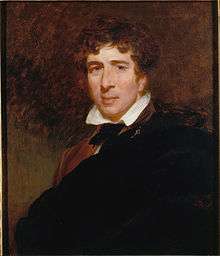Charles Kemble

Charles Kemble (25 November 1775 – 12 November 1854) was a British actor.
Life
The youngest son of Roger Kemble, and younger brother of John Philip Kemble, Stephen Kemble and Sarah Siddons, he was born at Brecon, South Wales. Like John Philip, he was educated at Douai. After returning to England in 1792, he obtained a job in the post office, but soon resigned to go on the stage, making his first recorded appearance at Sheffield as Orlando in As You Like It in that year. During the early part of his career as an actor he slowly gained popularity. For a considerable time he played with his brother and sister, chiefly in secondary parts, and received little attention.

His first London appearance was on 21 April 1794, as Malcolm to his brother's Macbeth. Ultimately he won independent fame, especially in such characters as Archer in George Farquhar's Beaux' Stratagem, Dorincourt in Hannah Cowley's Belle's Stratagem, Charles Surface and Ranger in Benjamin Hoadley's Suspicious Husband. His Laërtes and Macduff were as accomplished as his brother's Hamlet and Macbeth. His production of Cymbeline in 1827 inaugurated the trend to historical accuracy in stagings of that play that reached a peak with Henry Irving at the turn of the century.
In comedy he was ably supported by his wife, Marie Therese De Camp, whom he married on 2 July 1806. His visit, with his daughter Fanny, to America during 1832 and 1834, aroused much enthusiasm. The later part of his career was beset by money troubles in connection with his joint proprietorship of Covent Garden theatre. He formally retired from the stage in December 1836, but his final appearance was on 10 April 1840. For some time he held the office of examiner of plays. In 1844-1845 he gave readings from Shakespeare at Willis's Rooms. Macready regarded his Cassio as incomparable, and summed him up as "a first-rate actor of second-rate parts."
See also
- See Gentleman's Magazine, January 1855
- Records of a Girlhood, by Frances Anne Kemble
Notes
References
 Chisholm, Hugh, ed. (1911). "Kemble". Encyclopædia Britannica (11th ed.). Cambridge University Press.
Chisholm, Hugh, ed. (1911). "Kemble". Encyclopædia Britannica (11th ed.). Cambridge University Press.
Further reading
- Oxberry, Dramatic Biography (London, 1826)
- Fitzgerald, The Kembles (London, 1871)
- Fanny Kemble, Record of a Girlhood (London, 1878)
- Lane (edited), Charles Kemble's Shakespearean Readings (second edition, London, 1879)
- Matthews, Actors and Actresses of Great Britain and the United States (volume ii, New York, 1886)
- Doran, Annals of the Stage (London, 1888)